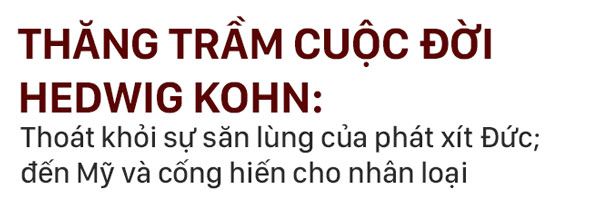Google honors Hedwig Kohn: Physicist 'smashes' Nazi chains
Today, April 5, 2019, Google Doodle changed its home page to celebrate Hedwig Kohn's 132th birthday. So who is Hedwig Kohn? What great contribution did she give to humanity? Invite readers to track.


Hedwig Kohn was born on April 5, 1887, she was a pioneering physicist before the Second World War (1939-1945).
Born in Breslau (today Wrocław, Poland) in a well-off family, whose father is Georg Kohn - a merchant and his mother is Helene Hancke - a noble lady, Hedwig Kohn is raised and educated. full.
She soon developed a love for a physics, which is why, after enrolling in the University of Breslau in 1907 with the title of the physics of the university, Hedwig Kohn continued to study for a doctorate under the guidance of of German physicist Otto Lummer in 1913.
During the time of World War I, Hedwig Kohn taught at the Physics Institute of a German university and continued to pursue with HDR in 1930 (By HDR was the standard to be appointed as professor at universities).

As a Jewish native living in Germany, Hedwig Kohn was forbidden to teach here in 1933 (by the Nazis at the time to deny Jews, forbidding them from serving the country).
After losing his job, Hedwig Kohn remained resilient in Germany for another 5 years with the job of a person completing the lighting research application contracts in the intense hunting of the Nazis.
By 1938, after becoming a victim of Nazi large-scale genocide against Jews, Hedwig Kohn's life turned to a new page.


Doodle design image on Google on April 5, 2019.Source: Google Doodle.
Through the great help of German atomic physicist Rudolf Ladenburg (who escaped Germany in 1932 and went to the United States to teach university), Hedwig Kohn was asked to join the American Women's University Association (AAUW). positions at 3 women's universities in the United States.
Life Hedwig Kohn has had many turning points since stepping into the land of flowers. Here, Hedwig Kohn returns with his passion for physics. She served as a lecturer at the Women's University of North Carolina University and Wellesley University in Massachusetts until 1952. This is also the year she received a professorship.
After retirement, Professor, Dr. Hedwig Kohn took up a research position at Duke University (North Carolina).
In the basement of the physical building, where his laboratory was located, Hedwig Kohn instructed the doctoral students, while continuing to study his work regarding electromagnetic radiation and atomic spectroscopy. and molecules.

After many years away from home and burning passion for physics, Hedwig Kohn's work created more than 20 publications, a patent and hundreds of pages of textbooks used to introduce students to the field. X-ray area (a set of techniques used to measure electromagnetic radiation, including visible light) in the 1960s.
In addition, female professors and doctors also developed measurements of radiometers. She wrote 270 pages in the top physical text of the 1930s and 1940s in Germany; and write many articles in scientific journals, some of which are still cited in the 1980s.
In 1964, after years of work and dedication in the United States, pioneering physicist Hedwig Kohn died at the age of 77. Her works, though more or less in use today, are still okay. The scientific world remembers forever.
Her life has also become a shining example for many of the chaos of war-torn young wrestlers. Hedwig Kohn continued to live up to the Nazis (with the Jewish descent), and Hedwig Kohn continued to live and passion so he could continue to devote himself to the physical world of mankind.
Once again, congratulations on the pioneering physics physics student Hedwig Kohn!
- Google honors Ignacio Anaya García - 'Father' of Mexican nachos makes diners fall in love
- Hoi An charm appears on Google Doodle July 16: What is the reason Google honors?
- A bunch of abandoned Nazi bunkers 70 years after World War II
- Who is Molière who Google Doodle honored?
- What is special about pretzel in Europe and America?
- That cute owl is like that, but they are
- Google Earth discovered a series of shocking secrets in Antarctica
- Google Knol lags far behind Wikipedia
- Syndrome K: Mysterious disease and spectacular trick for Nazi Germany?
- Google honors Olga Ladyzhenskaya: Mathematicians overcome 'fate's pain' when they were young
- Who is Cesária Évora who was honored by Google Doodle today?
- Special Google products and services
 The Indian prophet prodigy warned 3 events and what will happen on April 13, 2022
The Indian prophet prodigy warned 3 events and what will happen on April 13, 2022 Top 8 youngest professors in the world: Teaching university at the age of 18
Top 8 youngest professors in the world: Teaching university at the age of 18 Elena Cornaro Piscopia - The world's first female doctor of philosophy
Elena Cornaro Piscopia - The world's first female doctor of philosophy The ancient Greek philosopher was executed for understanding the Moon
The ancient Greek philosopher was executed for understanding the Moon